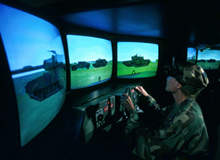
When you think of army vehicle manufacturers, you generally don’t think of traditional aerospace high-fliers such as Lockheed Martin and Northrop Grumman. But maybe you should get used to it, because both companies have entered prototypes into the US Army’s competition for the Joint Light Tactical Vehicle (JLTV) programme.
In fact, the JLTV programme has drawn five of the top six defence contractors as measured by global revenue in 2006. This is not surprising given that the JLTV mandate could be worth as much as $30bn over the coming decades, placing it in the same class as the largest US Air Force programmes, such as the joint strike fighter.
Size usually counts for less than expertise in winning contracts, however, so the JLTV competition is not just between the elephants of the industry, generally defined as those firms with over $10bn in revenues: Lockheed, Boeing, Northrop, BAE and General Dynamics (Raytheon is the only top contractor not competing). For the most part, the usual suspects are teaming with specialist firms in either ground vehicles or armour.
HANDICAPPING THE JLTV RACE
Three of the teams represent traditional competitor archetypes: the niche specialist, the incumbent, and the non-US conglomerate. Both partners on each team have experience in combat vehicle design and production, but each team has potential limitations or vulnerabilities that induced its constituents to seek partnership.
If the JLTV race has a dark horse, it would have to be Force Protection, the builder of the Cougar, Buffalo and Cheetah vehicles, and a charter contractor in the Mine Resistant Ambush Protected (MRAP) programme. On a huge army programme, however, size counts for something, so Force Protection recently announced that it would team up with DRS Technologies, which has niche specialties in the C3ISR space as well as automotive technology. This team is the only one that does not feature any of the top five defence integrator.
If the JLTV were classified as the successor to the Humvee, then the incumbent in the race would have to be AM General, which developed the Humvee a generation ago. Given the persistence of the roadside bomb threat, however, incumbency may be a double-edged sword in this particular race. Perhaps sensing this potential vulnerability, AM General formed a joint venture called General Tactical Vehicles to compete for the mandate. The counterpart is none other than General Dynamics, which has a long history of combat vehicle programmes, most notably the M-1 Abrams tank.
A third stereotype in any race is the foreign entry, in this case the BAE-Navistar team. The only non-US company among the top defence contractors, BAE probably has the most extensive experience with combat vehicles of any integrator in the JLTV race, while Navistar’s international military and government division is a traditional supplier of heavy trucks and engineering vehicles to the US Army, as well as the largest manufacturer of MRAP vehicles for the Pentagon.
The other three teams contain the arriviste class of aerospace firms. As a group, these teams trade-off size against the more focused expertise of the traditionalist teams.
THE ‘ALL BUT THE KITCHEN SINK’ TEAM: BOEING, TEXTRON, MILLENWORKS
Although a household name, Boeing is stepping outside its traditional expertise in competing for the JLTV mandate. As the builder of the venerable CH-47 Chinook heavy-lift helicopter, Boeing has a longstanding relationship with the army, but its previous experience with ground systems has either involved C3I, as in the Grenadier logistics tracking system, or missiles, as in last decade’s Avenger vehicle for Stinger SAMs.
In October 2007, Boeing signed separate teaming agreements with Textron Systems and MillenWorks, which subsequently closed the loop with their own bilateral JLTV agreement in December. Textron is a defence conglomerate with particular experience in electronics systems. Privately owned MillenWorks, by far the smallest of the three firms, specialises in high-end automotive technology for both on and off-road applications.
THE ‘OPPOSITES ATTRACT’ TEAM: NORTHROP GRUMMAN AND OSHKOSH TRUCK
Dating from the pre-merger history of its parents, Northrop has traditionally been the most aero-centric of the major US defence contractors. Like the other major integrators, Northrop has IT and electronics divisions that have contracted with the army, but unlike Boeing or General Dynamics, NG has heretofore not built either an army weapon or vehicle.
Consequently, Northrop needed a teammate with strong army vehicle experience, which it found in Oshkosh Truck, a leader in heavy-duty, off-road trucks such as the HEMTT and the heavy equipment transporter. Although lacking in-house armour expertise, Oshkosh has significant armour experience from collaborating with armour specialists such as Ceradyne and Plasan.
TEAM GOLIATH: LOCKHEED MARTIN
As befits its history, Lockheed is strongest in aerospace, but has recently diversified via acquisition into IT (ACS and Orincon in 2003) and naval systems (Sippican Holdings in 2004). Although the firm has won army mandates for missiles (MLRS) and C3ISR (warfighter information network or WIN-T), the JLTV represents Lockheed’s first foray into traditional ground platforms.
As the largest military contractor by revenue in the world, Lockheed is probably the only company that could plausibly think about going it alone but even with its diversified experience and vast size, Lockheed is partnering with Armor Holdings for the JLTV.
In a final irony, BAE bought Armor Holdings last year and rechristened it the Mobility and Protection Systems division. Therefore, BAE actually has two horses in the JLTV race, as its partnership with Navistar predated the Armor Holdings deal. So far, there has been little comment concerning potential conflicts of interest.



